Did All the White Sox Family Picture Frame
Exercise you remember this photograph? In the Usa, people take taken pains to banish it from the record of September eleven, 2001. The story behind it, though, and the search for the human being pictured in it, are our most intimate connection to the horror of that day.
In the flick, he departs from this earth like an arrow. Although he has not called his fate, he appears to have, in his last instants of life, embraced it. If he were not falling, he might very well exist flying. He appears relaxed, hurtling through the air. He appears comfortable in the grip of unimaginable move. He does not appear intimidated past gravity'south divine suction or past what awaits him. His arms are by his side, only slightly outriggered. His left leg is bent at the knee, almost casually. His white shirt, or jacket, or frock, is billowing free of his blackness pants. His black high-tops are still on his feet. In all the other pictures, the people who did what he did—who jumped—appear to be struggling against horrific discrepancies of scale. They are made puny by the backdrop of the towers, which loom similar colossi, and and so by the consequence itself. Some of them are shirtless; their shoes wing off equally they flail and autumn; they look confused, equally though trying to swim down the side of a mountain. The man in the moving-picture show, by contrast, is perfectly vertical, and so is in accord with the lines of the buildings behind him. He splits them, bisects them: Everything to the left of him in the picture is the North Tower; everything to the right, the S. Though oblivious to the geometric balance he has achieved, he is the essential element in the creation of a new flag, a imprint equanimous entirely of steel bars shining in the sun. Some people who look at the picture see stoicism, willpower, a portrait of resignation; others encounter something else—something discordant and therefore terrible: liberty. At that place is something almost rebellious in the man'southward posture, as though once faced with the inevitability of death, he decided to get on with information technology; as though he were a missile, a spear, bent on attaining his own end. He is, fifteen seconds past ix:41 a.m. EST, the moment the motion picture is taken, in the clutches of pure physics, accelerating at a rate of 30-two feet per second squared. He will presently be traveling at upwards of 150 miles per hour, and he is upside down. In the picture, he is frozen; in his life outside the frame, he drops and keeps dropping until he disappears.
The photographer is no stranger to history; he knows it is something that happens later. In the actual moment history is made, it is commonly made in terror and confusion, and so it is up to people like him—paid witnesses—to have the presence of mind to attend to its manufacture. The photographer has that presence of mind and has had information technology since he was a swain. When he was xx-1 years old, he was standing right behind Bobby Kennedy when Bobby Kennedy was shot in the head. His jacket was spattered with Kennedy'due south blood, but he jumped on a table and shot pictures of Kennedy'south open up and ebbing eyes, and and then of Ethel Kennedy crouching over her married man and begging photographers—begging him—not to accept pictures.
Richard Drew has never done that. Although he has preserved the jacket patterned with Kennedy's blood, he has never not taken a picture, never averted his eye. He works for the Associated Press. He is a journalist. It is not up to him to reject the images that fill his frame, because one never knows when history is made until one makes it. It is not even upward to him to distinguish if a body is alive or dead, considering the photographic camera makes no such distinctions, and he is in the business of shooting bodies, as all photographers are, unless they are Ansel Adams. Indeed, he was shooting bodies on the forenoon of September eleven, 2001. On assignment for the AP, he was shooting a maternity fashion show in Bryant Park, notable, he says, "because it featured actual significant models." He was fifty-4 years old. He wore glasses. He was thin in the scalp, greyness in the beard, hard in the head. In a lifetime of taking pictures, he has found a way to be both balmy-mannered and brusque, patient and very, very quick. He was doing what he always does at manner shows—"staking out existent manor"—when a CNN cameraman with an earpiece said that a plane had crashed into the N Tower, and Drew'southward editor rang his jail cell telephone. He packed his equipment into a bag and gambled on taking the subway downtown. Although it was still running, he was the only one on it. He got out at the Chambers Street station and saw that both towers had been turned into smokestacks. Staking out his real estate, he walked west, to where ambulances were gathering, considering rescue workers "usually won't throw you out." And so he heard people gasping. People on the basis were gasping because people in the edifice were jumping. He started shooting pictures through a 200mm lens. He was standing between a cop and an emergency technician, and each fourth dimension one of them cried, "There goes another," his camera found a falling body and followed information technology down for a 9- or twelve-shot sequence. He shot ten or fifteen of them before he heard the rumbling of the Southward Tower and witnessed, through the winnowing exclusivity of his lens, its collapse. He was engulfed in a mobile ruin, just he grabbed a mask from an ambulance and photographed the elevation of the North Belfry "exploding like a mushroom" and raining droppings. He discovered that in that location is such a affair as being too close, and, deciding that he had fulfilled his professional obligations, Richard Drew joined the throng of ashen humanity heading north, walking until he reached his office at Rockefeller Center.
There was no terror or confusion at the Associated Printing. At that place was, instead, that feeling of history being manufactured; although the part was every bit crowded every bit he'd always seen it, there was, instead, "the wonderful calm that comes into play when people are really doing their jobs." So Drew did his: He inserted the disc from his digital camera into his laptop and recognized, instantly, what simply his camera had seen—something iconic in the extended annihilation of a falling man. He didn't expect at any of the other pictures in the sequence; he didn't take to. "You learn in photo editing to look for the frame," he says. "You have to recognize it. That pic only jumped off the screen considering of its verticality and symmetry. Information technology just had that look."
He sent the image to the AP's server. The adjacent morning time, information technology appeared on folio vii of The New York Times. It appeared in hundreds of newspapers, all over the country, all over the earth. The man within the frame—the Falling Man—was not identified.
They began jumping not long after the showtime plane hit the Due north Tower, not long after the fire started. They kept jumping until the belfry fell. They jumped through windows already cleaved and and so, after, through windows they bankrupt themselves. They jumped to escape the smoke and the fire; they jumped when the ceilings fell and the floors complanate; they jumped only to breathe once more before they died. They jumped continually, from all four sides of the building, and from all floors above and around the building's fatal wound. They jumped from the offices of Marsh & McLennan, the insurance company; from the offices of Cantor Fitzgerald, the bond-trading company; from Windows on the World, the eating house on the 106th and 107th floors—the top. For more than an hour and a half, they streamed from the building, 1 after another, consecutively rather than en masse, as if each private required the sight of another individual jumping before mustering the courage to jump himself or herself. One photo, taken at a distance, shows people jumping in perfect sequence, like parachutists, forming an arc equanimous of 3 plummeting people, evenly spaced. Indeed, in that location were reports that some tried parachuting, earlier the strength generated by their fall ripped the drapes, the tablecloths, the desperately gathered textile, from their easily. They were all, obviously, very much live on their mode down, and their way down lasted an guess count of 10 seconds. They were all, obviously, not but killed when they landed but destroyed, in body though not, one prays, in soul. One striking a fireman on the ground and killed him; the fire-eater's body was all-powerful by Begetter Mychal Judge, whose own death, shortly thereafter, was embraced as an example of martyrdom after the photo—the redemptive tableau—of firefighters carrying his body from the rubble made its style effectually the world.
From the beginning, the spectacle of doomed people jumping from the upper floors of the World Trade Center resisted redemption. They were called "jumpers" or "the jumpers," as though they represented a new lemminglike course. The trial that hundreds endured in the building so in the air became its ain kind of trial for the thousands watching them from the footing. No one ever got used to it; no one who saw it wished to see it once more, although, of grade, many saw it once again. Each jumper, no matter how many there were, brought fresh horror, elicited shock, tested the spirit, struck a lasting accident. Those tumbling through the air remained, past all accounts, eerily silent; those on the footing screamed. It was the sight of the jumpers that prompted Rudy Giuliani to say to his police commissioner, "We're in uncharted waters now." It was the sight of the jumpers that prompted a woman to wail, "God! Save their souls! They're jumping! Oh, please God! Save their souls!" And it was, at last, the sight of the jumpers that provided the cosmetic to those who insisted on saying that what they were witnessing was "similar a moving-picture show," for this was an catastrophe as unimaginable as it was unbearable: Americans responding to the worst terrorist set on in the history of the world with acts of heroism, with acts of cede, with acts of generosity, with acts of martyrdom, and, by terrible necessity, with one prolonged act of—if these words can exist applied to mass murder—mass suicide.
In most American Newspapers, the photograph that Richard Drew took of the Falling Man ran in one case and never over again. Papers all over the state, from the Fort Worth Star-Telegram to the Memphis Commercial Appeal to The Denver Mail, were forced to defend themselves against charges that they exploited a human's death, stripped him of his dignity, invaded his privacy, turned tragedy into leering pornography. Almost letters of complaint stated the obvious: that someone seeing the picture show had to know who information technology was. Still, even every bit Drew'south photograph became at one time iconic and impermissible, its subject remained unnamed. An editor at the Toronto Globe and Mail assigned a reporter named Peter Cheney to solve the mystery. Cheney at first despaired of his task; the entire city, afterwards all, was wallpapered with Kinkoed flyers advertizing the faces of the missing and the lost and the expressionless. And so he applied himself, sending the digital photograph to a store that antiseptic and enhanced it. Now information emerged: It appeared to him that the human was most probable not black only night-skinned, probably Latino. He wore a goatee. And the white shirt billowing from his black pants was not a shirt but rather appeared to be a tunic of some sort, the kind of jacket a eating house worker wears. Windows on the World, the restaurant at the top of the North Tower, lost seventy-nine of its employees on September 11, equally well as 90-one of its patrons. It was likely that the Falling Human being numbered among them. But which i was he? Over dinner, Cheney spent an evening discussing this question with friends, and then said goodnight and walked through Times Square. It was subsequently midnight, viii days later the attacks. The missing posters were still everywhere, but Cheney was able to focus on 1 that seemed to nowadays itself to him—a poster portraying a man who worked at Windows as a pastry chef, who was dressed in a white tunic, who wore a goatee, who was Latino. His name was Norberto Hernandez. He lived in Queens. Cheney took the enhanced print of the Richard Drew photograph to the family, in item to Norberto Hernandez'due south brother Tino and sis Milagros. They said yes, that was Norberto. Milagros had watched footage of the people jumping on that terrible morning, before the telly stations stopped showing it. She had seen one of the jumpers distinguished by the grace of his autumn—by his resemblance to an Olympic diver—and surmised that he had to be her brother. Now she saw, and she knew. All that remained was for Peter Cheney to confirm the identification with Norberto's wife and his three daughters. They did not want to talk to him, especially after Norberto's remains were establish and identified by the stamp of his Dna—a body, an arm. Then he went to the funeral. He brought his print of Drew'south photograph with him and showed information technology to Jacqueline Hernandez, the oldest of Norberto'southward three daughters. She looked briefly at the moving picture, then at Cheney, and ordered him to leave.
What Cheney remembers her saying, in her acrimony, in her offended grief: "That piece of shit is non my father."
The resistance to the image—to the images—started early, started immediately, started on the footing. A mother whispering to her distraught child a consoling lie: "Maybe they're just birds, dearest." Bill Feehan, 2d in command at the fire department, chasing a bystander who was panning the jumpers with his video photographic camera, demanding that he plough it off, bellowing, "Don't you have any homo decency?" before dying himself when the building came down. In the about photographed and videotaped day in the history of the world, the images of people jumping were the just images that became, by consensus, taboo—the only images from which Americans were proud to avoid their eyes. All over the world, people saw the human stream debouch from the peak of the North Belfry, but here in the United states, we saw these images merely until the networks decided not to permit such a harrowing view, out of respect for the families of those so publicly dying. At CNN, the footage was shown live, before people working in the newsroom knew what was happening; then, after what Walter Isaacson, who was then chairman of the network'south news bureau, calls "agonized discussions" with the "standards guy," it was shown only if people in information technology were blurred and unidentifiable; and then information technology was not shown at all.
Then it went. In 9/11, the documentary extracted from videotape shot by French brothers Jules and Gedeon Naudet, the filmmakers included a sonic sampling of the booming, rattling explosions the jumpers made upon impact just edited out the nigh agonizing thing almost the sounds: the sheer frequency with which they occurred. In Rudy, the docudrama starring James Forest in the office of Mayor Giuliani, archival footage of the jumpers was outset included, then cutting out. In Here Is New York, an all-encompassing exhibition of 9/eleven images culled from the work of photographers both amateur and professional, at that place was, in the section titled "Victims," only one picture show of the jumpers, taken at a respectful distance; attached to it, on the Here Is New York Web site, a visitor offers this commentary: "This prototype is what made me glad for censuring [sic] in the countless pursuant media coverage." More and more than, the jumpers—and their images—were relegated to the Internet underbelly, where they became the provenance of the shock sites that also traffic in the autopsy photos of Nicole Brown Simpson and the videotape of Daniel Pearl's execution, and where information technology is impossible to expect at them without attendant feelings of shame and guilt. In a nation of voyeurs, the desire to face the most disturbing aspects of our well-nigh disturbing day was somehow ascribed to voyeurism, as though the jumpers' experience, instead of existence central to the horror, was tangential to information technology, a sideshow best forgotten.
It was no sideshow. The ii most reputable estimates of the number of people who jumped to their deaths were prepared by The New York Times and USA Today. They differed dramatically. The Times, admittedly conservative, decided to count only what its reporters actually saw in the footage they collected, and information technology arrived at a figure of l. USA Today, whose editors used eyewitness accounts and forensic show in add-on to what they found on video, came to the conclusion that at least two hundred people died by jumping—a count that the newspaper said regime did not dispute. Both are intolerable estimates of human loss, only if the number provided past USA Today is accurate, then between 7 and 8 percent of those who died in New York Metropolis on September 11, 2001, died past jumping out of the buildings; information technology means that if we consider just the Northward Belfry, where the vast majority of jumpers came from, the ratio is more than like i in half dozen.
And still if one calls the New York Medical Examiner's Office to learn its ain approximate of how many people might have jumped, one does not get an answer but an admonition: "We don't similar to say they jumped. They didn't leap. Nobody jumped. They were forced out, or blown out." And if one Googles the words "how many jumped on ix/xi," one falls into some blogger's trap, slugged "Go Abroad, No Jumpers Hither," where the allurement is one'southward own need to know: "I've got at to the lowest degree three entries in my referrer logs that show someone is doing a search on Google for 'how many people jumped from WTC.' My September 11 mail had made mention of that terrible occurance [sic], and then now whatsoever pervert looking for that volition go my site's URL. I'k disgusted. I tried, but cannot find whatever reason someone would want to know something like that…. Whatever. If that's why you're hither—yous're busted. Now go away."
Eric Fischl did not go away. Neither did he plough away or avoid his optics. A year before September 11, he had taken photographs of a model tumbling around on the floor of a studio. He had thought of using the photographs as the basis of a sculpture. Now, though, he had lost a friend who had been trapped on the 106th floor of the Northward Tower. Now, as he worked on his sculpture, he sought to limited the extremity of his feelings by making a monument to what he calls the "extremity of pick" faced by the people who jumped. He worked 9 months on the larger-than-life bronze he called Tumbling Woman, and as he transformed a woman tumbling on the flooring into a woman tumbling through eternity, he succeeded in transfiguring the very local horror of the jumpers into something universal—in redeeming an image many regarded as irredeemable. Indeed, Tumbling Woman was perhaps the redemptive image of 9/11—and yet it was non only resisted; it was rejected. The day after Tumbling Woman was exhibited in New York's Rockefeller Center, Andrea Peyser of the New York Post denounced it in a column titled "Shameful Art Assail," in which she argued that Fischl had no right to deadfall grieving New Yorkers with the very distillation of their own sadness … in which she essentially argued the right to expect abroad. Considering information technology was based on a model rolling on the flooring, the statue was treated as an evocation of impact—as a portrayal of literal, rather than figurative, violence.
"I was trying to say something virtually the fashion we all feel," Fischl says, "only people thought I was trying to say something about the manner they feel—that I was trying to have abroad something only they possessed. They thought that I was trying to say something about the people they lost. 'That image is non my male parent. You don't even know my father. How cartel you attempt telling me how I feel almost my male parent?'" Fischl wound up apologizing—"I was ashamed to have added to anybody'southward pain"—simply it didn't thing.
Jerry Speyer, a trustee of the Museum of Modern Art who runs Rockefeller Center, ended the exhibition of Tumbling Woman afterward a week. "I pleaded with him non to do it," Fischl says. "I thought that if we could wait it out, other voices would piping up and deport the day. He said, 'You don't understand. I'grand getting bomb threats.' I said, 'People who just lost loved ones to terrorism are not going to bomb somebody.' He said, 'I can't take that adventure.'"
Photographs prevarication. Even cracking photographs. Specially swell photographs. The Falling Man in Richard Drew's movie roughshod in the style suggested by the photograph for only a fraction of a second, and then kept falling. The photograph functioned as a study of doomed verticality, a fantasia of directly lines, with a human being slivered at the center, like a spike. In truth, however, the Falling Man vicious with neither the precision of an arrow nor the grace of an Olympic diver. He roughshod like everyone else, similar all the other jumpers—trying to hold on to the life he was leaving, which is to say that he vicious badly, inelegantly. In Drew's famous photograph, his humanity is in accordance with the lines of the buildings. In the residue of the sequence—the eleven outtakes—his humanity stands apart. He is non augmented by aesthetics; he is but human, and his humanity, startled and in some cases horizontal, obliterates everything else in the frame.
In the consummate sequence of photographs, truth is subordinate to the facts that sally slowly, pitilessly, frame by frame. In the sequence, the Falling Man shows his face to the camera in the 2 frames earlier the published ane, and subsequently that there is an unveiling, nearly an unpeeling, equally the forcefulness generated by the fall rips the white jacket off his back. The facts that emerge from the entire sequence advise that the Toronto reporter, Peter Cheney, got some things right in his endeavour to solve the mystery presented by Drew'south published photo. The Falling Human being has a dark bandage to his skin and wears a goatee. He is probably a food-service worker. He seems lanky, with the length and narrowness of his face—similar that of a medieval Christ—possibly accentuated by the push button of the wind and the pull of gravity. But 70-9 people died on the morning time of September 11 after going to work at Windows on the World. Another twenty-one died while in the utilise of Forte Food, a catering service that fed the traders at Cantor Fitzgerald. Many of the dead were Latino, or light-skinned black men, or Indian, or Arab. Many had dark pilus cut brusque. Many had mustaches and goatees. Indeed, to anyone trying to figure out the identity of the Falling Man, the few salient characteristics that tin exist discerned in the original series of photographs raise every bit many possibilities every bit they exclude. There is, however, one fact that is decisive. Whoever the Falling Human may be, he was wearing a bright-orange shirt under his white top. It is the one inarguable fact that the brute force of the fall reveals. No ane can know if the tunic or shirt, open at the back, is being pulled away from him, or if the fall is simply trigger-happy the white textile to pieces. But anyone tin can see he is wearing an orange shirt. If they saw these pictures, members of his family unit would be able to come across that he is wearing an orange shirt. They might fifty-fifty be able to remember if he endemic an orange shirt, if he was the kind of guy who would ain an orangish shirt, if he wore an orange shirt to work that morning time. Surely they would; surely someone would call back what he was wearing when he went to work on the last morning of his life.....
Simply now the Falling Human being is falling through more than the blank blue sky. He is falling through the vast spaces of memory and picking up speed.
Neil Levin, Executive Director of the Port Potency of New York and New Bailiwick of jersey, had breakfast at Windows on the World, on the 106th floor of the World Trade Center'southward North Tower, on the morning of September 11. He never came home. His wife, Christy Ferer, won't talk well-nigh any of the particulars of his decease. She works for New York mayor Mike Bloomberg as the liaison between the mayor's role and the 9/11 families and has poured the energy angry by her grief into her piece of work, which, before the kickoff ceremony of the assail, called for her to visit tv set executives and ask them not to employ the near disturbing footage—including the footage of the jumpers—in their memorial broadcasts. She is a shut friend of Eric Fischl's, as was her hubby, and so when the creative person asked, she agreed to take a wait at Tumbling Woman. It, in her words, "hitting me in the gut," but she felt that Fischl had the correct to create and exhibit it. Now she's come to the conclusion that the controversy may accept been largely a matter of timing. Maybe it was just also soon to show something like that. Afterwards all, non long before her husband died, she traveled with him to Auschwitz, where piles of confiscated eyeglasses and extracted molar fillings are on showroom. "They can show that now," she says. "But that was a long time ago. They couldn't testify things like that then…."
In fact, they did, at least in photographic form, and the pictures that came out of the death camps of Europe were treated equally essential acts of witness, without item regard to the sensitivities of those who appeared in them or the surviving families of the dead. They were shown, as Richard Drew's photographs of the freshly assassinated Robert Kennedy were shown. They were shown, as the photographs of Ethel Kennedy pleading with photographers not to accept photographs were shown. They were shown as the photo of the piddling Vietnamese girl running naked subsequently a napalm attack was shown. They were shown every bit the photograph of Begetter Mychal Judge, graphically and unmistakably dead, was shown, and accepted as a kind of testament. They were shown as everything is shown, for, like the lens of a camera, history is a strength that does not discriminate. What distinguishes the pictures of the jumpers from the pictures that accept come before is that we—nosotros Americans—are being asked to discriminate on their behalf. What distinguishes them, historically, is that we, as patriotic Americans, accept agreed non to look at them. Dozens, scores, possibly hundreds of people died by leaping from a called-for building, and we have somehow taken it upon ourselves to deem their deaths unworthy of witness—because nosotros accept somehow accounted the act of witness, in this i regard, unworthy of us.
Catherine Hernandez never saw the photo the reporter carried nether his arm at her father's funeral. Neither did her mother, Eulogia. Her sister Jacqueline did, and her outrage assured that the reporter left—was forcibly evicted—before he did any more damage. But the moving-picture show has followed Catherine and Eulogia and the entire Hernandez family unit. There was zero more important to Norberto Hernandez than family. His motto: "Together Forever." But the Hernandezes are not together anymore. The picture split them. Those who knew, right abroad, that the flick was non Norberto—his wife and his daughters—have go estranged from those who pondered the possibility that it was him for the benefit of a reporter'due south notepad. With Norberto alive, the extended family all lived in the same neighborhood in Queens. Now Eulogia and her daughters accept moved to a house on Long Island because Tatiana—who is now xvi and who bears a resemblance to Norberto Hernandez: the broad face up, the nighttime brows, the thick dark lips, thinly grinning—kept seeing visions of her begetter in the house and kept hearing the whispered suggestions that he died by jumping out a window.
He could not take died by jumping out a window.
All over the world, people who read Peter Cheney'southward story believe that Norberto died by jumping out a window. People have written poems about Norberto jumping out a window. People have called the Hernandezes with offers of coin—either charity or payment for interviews—because they read about Norberto jumping out a window. But he couldn't have jumped out a window, his family unit knows, considering he wouldn't have jumped out a window: not Papi. "He was trying to come home," Catherine says i morning, in a living room primarily busy with framed photographs of her father. "He was trying to come home to u.s., and he knew he wasn't going to make it by jumping out a window." She is a lovely, nighttime-skinned, dark-brown-eyed daughter, twenty-two years old, dressed in a T-shirt and sweats and sandals. She is sitting on a couch next to her mother, who is caramel-colored, with coppery hair tied close to her scalp, and who is wearing a cotton apparel checked with the colour of the heaven. Eulogia speaks one-half the time in determined English, and so, when she gets frustrated with the rate of revelation, pours rapid-burn Spanish into the ear of her girl, who translates. "My mother says she knows that when he died, he was thinking about united states of america. She says that she could see him thinking about us. I know that sounds strange, but she knew him. They were together since they were xv." The Norberto Hernandez Eulogia knew would not have been deterred past fume or by fire in his effort to come home to her. The Norberto Hernandez she knew would have endured whatsoever pain before he jumped out of a window. When the Norberto Hernandez she knew died, his eyes were fixed on what he saw in his middle—the faces of his wife and his daughters—and not on the terrible beauty of an empty sky.
How well did she know him? "I dressed him," Eulogia says in English, a smile actualization on her face at the same fourth dimension as a shiny coat of tears. "Every morning. That forenoon, I call back. He wore Erstwhile Navy underwear. Light-green. He wore black socks. He wore blue pants: jeans. He wore a Casio watch. He wore an Sometime Navy shirt. Bluish. With checks." What did he wear after she drove him, every bit she always did, to the subway station and watched him moving ridge to her every bit he disappeared down the stairs? "He changed clothes at the eating place," says Catherine, who worked with her male parent at Windows on the World. "He was a pastry chef, and then he wore white pants, or chef's pants—you know, black-and-white check. He wore a white jacket. Nether that, he had to wearable a white T-shirt." What about an orange shirt? "No," Eulogia says. "My married man did non have an orange shirt."
At that place are pictures. There are pictures of the Falling Human as he savage. Practise they want to see them? Catherine says no, on her mother'due south behalf—"My female parent should not see"—but then, when she steps outside and sits downwardly on the steps of the front porch, she says, "Please—testify me. Hurry. Before my mother comes." When she sees the twelve-frame sequence, she lets out a gasping, muted call for her mother, but Eulogia is already over her shoulder, reaching for the pictures. She looks at them 1 after another, and and so her face up fixes itself into an expression of triumph and scorn. "That is not my husband," she says, handing the photographs dorsum. "You see? Only I know Norberto." She reaches for the photographs again, and then, after studying them, shakes her head with a vehement finality. "The man in this picture is a black human." She asks for copies of the pictures so that she can bear witness them to the people who believed that Norberto jumped out a window, while Catherine sits on the step with her palm spread over her heart. "They said my father was going to hell because he jumped," she says. "On the Internet. They said my begetter was taken to hell with the devil. I don't know what I would have washed if information technology was him. I would accept had a nervous breakdown, I guess. They would have constitute me in a mental ward somewhere…."
Her mother is standing at the front door, about to become back inside her business firm. Her face has already lost its belligerent pride and has turned once over again into a mask of composed, nigh wistful sadness. "Please," she says as she closes the door in a stain of morning sunlight. "Please clear my husband's name."
A phone rings in Connecticut. A woman answers. A homo on the other terminate is looking to identify a photo that ran in The New York Times on September 12, 2001. "Tell me what the photo looks like," she says. It's a famous movie, the man says—the famous moving-picture show of a human being falling. "Is it the one chosen 'Swan Swoop' on Rotten.com?" the woman asks. Information technology may be, the man says. "Yes, that might have been my son," the woman says.
She lost both her sons on September 11. They worked together at Cantor Fitzgerald. They worked on the equities desk. They worked dorsum-to-back. No, the homo on the phone says, the homo in the photograph is probably a food-service worker. He's wearing a white jacket. He'south upside down. "Then that's not my son," she says. "My son was wearing a dark shirt and khaki pants."
She knows what he was wearing because of her determination to know what happened to her sons on that day—because of her determination to look and to see. She did not start with that determination. She stopped reading the newspaper afterward September xi, stopped watching Television. And so, on New Year's Eve, she picked upwardly a copy of The New York Times and saw, in a yr-end review, a picture of Cantor Fitzgerald employees crowding the edge of the cliff formed by a dying building. In the posture—the attitude—of one of them, she thought she recognized the habits of her son. Then she called the lensman and asked him to enlarge and analyze the picture. Demanded that he do it. And then she knew, or knew as much as it was possible to know. Both of her sons were in the picture. One was continuing in the window, almost brazenly. The other was sitting inside. She does not need to say what may take happened next.
"The thing I hold was that both of my sons were together," she says, her instantaneous tears lifting her voice an octave. "But I sometimes wonder how long they knew. They're puzzled, they're uncertain, they're scared—only when did they know? When did the moment come up when they lost hope? Perhaps it came so quick…."
The man on the phone does non ask if she thinks her sons jumped. He does not have it in him, and anyway, she has given him an answer.
The Hernandezes looked at the decision to leap as a betrayal of honey—equally something Norberto was being accused of. The woman in Connecticut looks at the decision to jump as a loss of hope—as an absence that we, the living, now have to live with. She chooses to alive with it by looking, by seeing, past trying to know—by making an act of private witness. She could take chosen to continue her eyes airtight. And then now the man on the telephone asks the question that he called to ask in the first identify: Did she brand the right choice?
"I fabricated the just choice I could take made," the woman answers. "I could never have fabricated the choice not to know."
Catherine Hernandez thought she knew who the Falling Man was as soon as she saw the series of pictures, but she wouldn't say his name. "He had a sister who was with him that morning," she said, "and he told his mother that he would take care of her. He would never take left her lone past jumping." She did say, however, that the man was Indian, so it was easy to effigy out that his proper name was Sean Singh. But Sean was too minor to be the Falling Human being. He was make clean-shaven. He worked at Windows on the Globe in the audiovisual department, so he probably would have been wearing a shirt and necktie instead of a white chef'southward glaze. None of the one-time Windows employees who were interviewed believe the Falling Homo looks anything similar Sean Singh.
Besides, he had a sis. He never would have left her lone.
A director at Windows looked at the pictures once and said the Falling Man was Wilder Gomez. Then a few days after he studied them closely and inverse his listen. Wrong hair. Incorrect clothes. Incorrect trunk type. It was the same with Charlie Mauro. Information technology was the same with Junior Jimenez. Junior worked in the kitchen and would have been wearing checked pants. Charlie worked in purchasing and had no cause to wear a white jacket. As well, Charlie was a very large man. The Falling Man appears fairly stout in Richard Drew'southward published photo but about elongated in the rest of the sequence.
The residue of the kitchen workers were, similar Norberto Hernandez, eliminated from consideration by their outfits. The banquet servers may have been wearing white and blackness, but no 1 remembered whatever banquet server who looked anything similar the Falling Man.
Forte Food was the other food-service company that lost people on September 11, 2001. Simply all of its male employees worked in the kitchen, which means that they wore either checked or white pants. And nobody would have been immune to wear an orangish shirt under the white serving coat.
But someone who used to work for Forte remembers a guy who used to come around and get food for the Cantor executives. Black guy. Tall, with a mustache and a goatee. Wore a chef's glaze, open, with a loud shirt underneath.
Nobody at Cantor remembers anyone like that.
Of grade, the only style to find out the identity of the Falling Man is to telephone call the families of anyone who might be the Falling Man and inquire what they know about their son's or husband'due south or father's terminal day on earth. Ask if he went to piece of work wearing an orange shirt.
Just should those calls be made? Should those questions be asked? Would they but heap hurting upon the already anguished? Would they be regarded equally an insult to the memory of the dead, the way the Hernandez family regarded the imputation that Norberto Hernandez was the Falling Man? Or would they exist regarded as steps to some act of redemptive witness?
Jonathan Briley worked at Windows on the World. Some of his coworkers, when they saw Richard Drew's photographs, thought he might be the Falling Man. He was a lite-skinned black man. He was over 6 five. He was forty-3. He had a mustache and a goatee and close-cropped hair. He had a wife named Hillary.
Jonathan Briley'due south father is a preacher, a homo who has devoted his whole life to serving the Lord. Subsequently September eleven, he gathered his family together to ask God to tell him where his son was. No: He demanded it. He used these words: "Lord, I demand to know where my son is." For three hours straight, he prayed in his deep voice, until he spent the grace he had accumulated over a lifetime in the insistence of his appeal.
The next day, the FBI called. They'd found his son'due south body. It was, miraculously, intact.
The preacher's youngest son, Timothy, went to place his brother. He recognized him by his shoes: He was wearing black high-tops. Timothy removed ane of them and took it home and put information technology in his garage, equally a kind of memorial.
Timothy knew all virtually the Falling Human. He is a cop in Mountain Vernon, New York, and in the calendar week afterwards his brother died, someone had left a September 12 paper open up in the locker room. He saw the photo of the Falling Man and, in anger, he refused to look at it again. Just he couldn't throw it away. Instead, he stuffed information technology in the bottom of his locker, where—similar the black shoe in his garage—it became permanent.
Jonathan's sis Gwendolyn knew most the Falling Man, too. She saw the picture the twenty-four hour period information technology was published. She knew that Jonathan had asthma, and in the fume and the heat would have done anything just to breathe….
The both of them, Timothy and Gwendolyn, knew what Jonathan wore to work on near days. He wore a white shirt and black pants, along with the high-height black shoes. Timothy also knew what Jonathan sometimes wore under his shirt: an orange T-shirt. Jonathan wore that orange T-shirt everywhere. He wore that shirt all the time. He wore it then ofttimes that Timothy used to make fun of him: When are you gonna get rid of that orange T-shirt, Slim?
Just when Timothy identified his brother's body, none of his clothes were recognizable except the black shoes. And when Jonathan went to work on the morning of September xi, 2001, he'd left early on and kissed his wife goodbye while she was yet sleeping. She never saw the clothes he was wearing. After she learned that he was dead, she packed his clothes away and never inventoried what specific manufactures of clothing might be missing.
Is Jonathan Briley the Falling Man? He might exist. Simply mayhap he didn't leap from the window as a betrayal of dear or because he lost hope. Perchance he jumped to fulfill the terms of a phenomenon. Maybe he jumped to come dwelling house to his family unit. Peradventure he didn't spring at all, because no one can jump into the arms of God.
Oh, no. Y'all have to autumn.
Yep, Jonathan Briley might exist the Falling Man. But the only certainty we have is the certainty we had at the start: At fifteen seconds afterward 9:41 a.m., on September 11, 2001, a lensman named Richard Drew took a movie of a man falling through the sky—falling through time besides as through infinite. The picture went all effectually the world, and and so disappeared, as if we willed it abroad. One of the most famous photographs in human history became an unmarked grave, and the homo cached inside its frame—the Falling Human being—became the Unknown Soldier in a state of war whose terminate we have non yet seen. Richard Drew's photograph is all nosotros know of him, and even so all nosotros know of him becomes a measure of what we know of ourselves. The moving picture is his cairn, and like the monuments dedicated to the retentiveness of unknown soldiers everywhere, it asks that we wait at information technology, and make 1 simple acknowledgment.
That we have known who the Falling Homo is all along.
Additional Reporting past Andrew Chaikivsky.
This content is created and maintained by a 3rd party, and imported onto this page to aid users provide their email addresses. Yous may be able to find more than data well-nigh this and similar content at piano.io
Source: https://www.esquire.com/news-politics/a48031/the-falling-man-tom-junod/
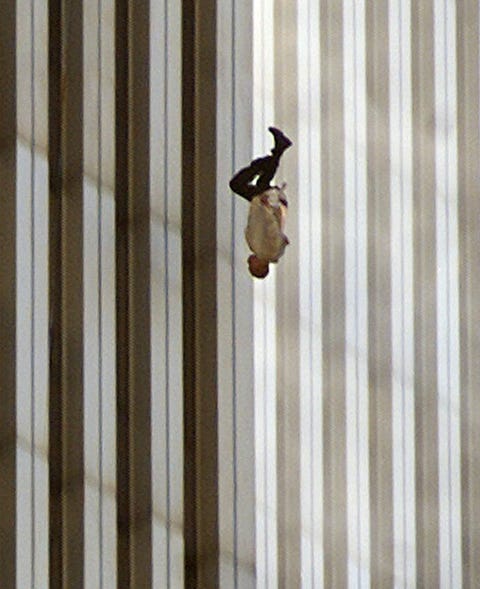

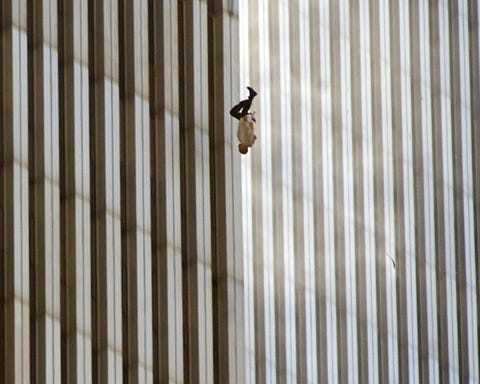
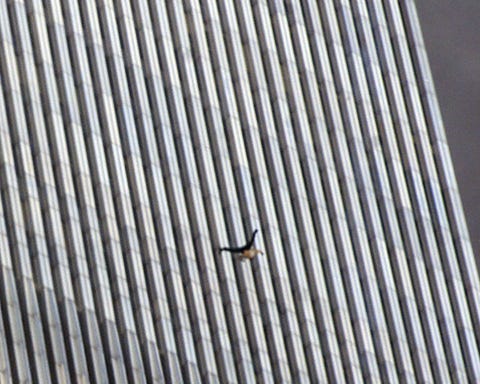
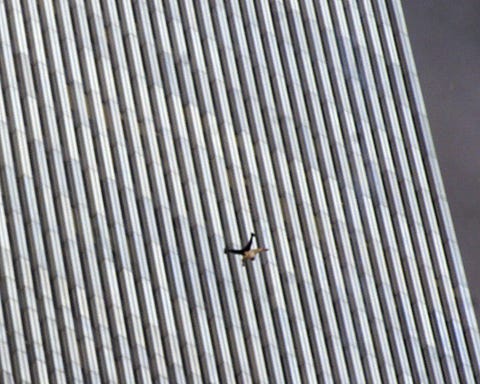
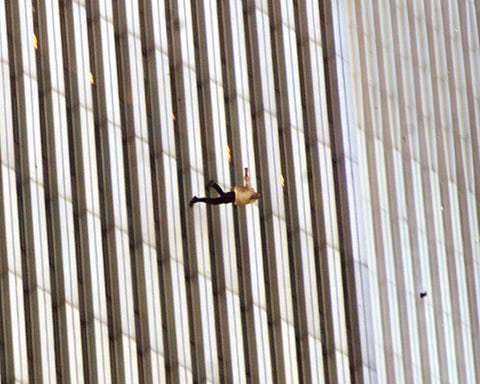
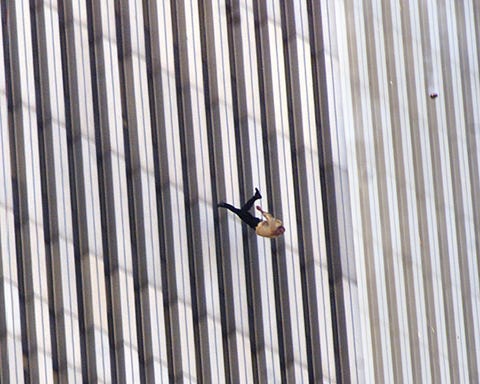
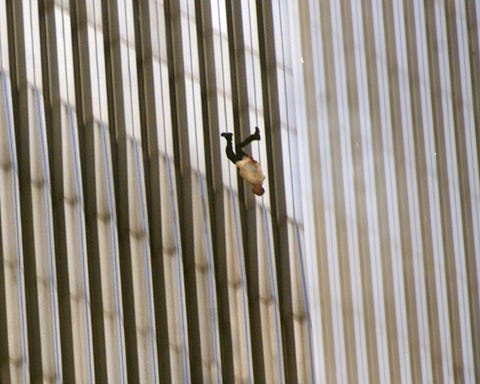

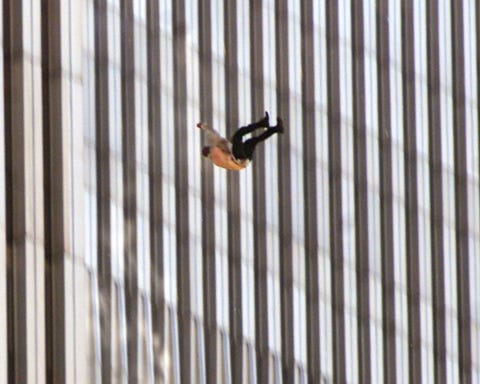
0 Response to "Did All the White Sox Family Picture Frame"
Post a Comment